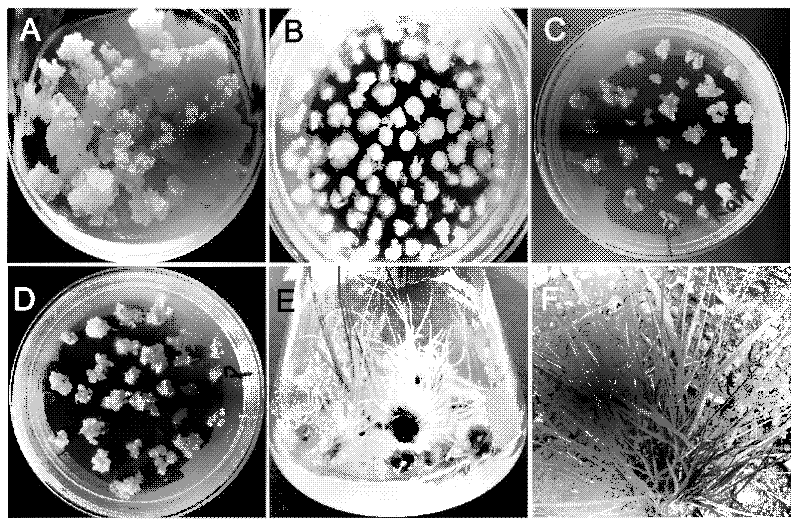Phragmites complexin gene papcs and its application
A plant and gene technology, applied in the remediation of heavy metal-contaminated soil, reed plant complexin gene PaPCS and its application in the cultivation of heavy metal-resistant plants, to achieve the effect of enriching heavy metals and improving the ability to resist heavy metals
- Summary
- Abstract
- Description
- Claims
- Application Information
AI Technical Summary
Problems solved by technology
Method used
Image
Examples
Embodiment 1
[0023] The cloning of embodiment 1, PaPCS
[0024] 1.1 Extraction of reed total RNA
[0025] (1) Put the reed material into a pre-cooled mortar, add liquid nitrogen and quickly grind it into a uniform powder. Pay attention to ensure that the material is immersed in liquid nitrogen during the grinding process.
[0026] (2) After the liquid nitrogen volatilizes, quickly transfer the material into a pre-cooled centrifuge tube, add 1ml TRIZOL solution for every 50-100mg of tissue material, mix well, place it at room temperature for 5min, centrifuge at 12000r / min, 2-8℃ for 10min precipitation.
[0027] (3) Add 0.2ml of chloroform to every 1ml of TRIZOL solution, oscillate for 15sec to mix well, leave at room temperature for 5min, centrifuge at 12000r / min, 2-8°C for 15min.
[0028] (4) Take the supernatant, add 0.5ml of isopropanol to every 1ml of TRIZOL, mix well, and place at room temperature for 10-20min.
[0029] (5) Centrifuge at 12,000 r / min at 2-8°C for 10 minutes, and di...
Embodiment 2
[0106] Embodiment 2, the construction of plant expression vector
[0107] 2.1 Obtaining the target gene
[0108] Primer design and PCR reaction system and conditions:
[0109] (1) Design the following pair of PCR amplification primers, and introduce two enzyme cutting sites SacI and XbalI contained in the plant expression vector pROK2 (purchased from Bao Biological Engineering Co., Ltd.).
[0110] P4: 5′-GCTCTAGAATGGAGATGCCGTCTCTGTA-3′
[0111] SacI
[0112]P5: 5′-GTCGAGCTCCTAATGTGATGGTGGCACATG-3′
[0113] wxya
[0114] (2) PCR reaction system:
[0115]
[0116] (3) PCR reaction conditions are
[0117] 94°C for 5min; 94°C for 30sec, 60°C for 30sec, 72°C for 2min, 35 cycles; finally 72°C for 7min. The PCR products were recovered by electrophoresis and used in subsequent reactions.
[0118] 2.2 Construction of expression vector
[0119] The cDNA with SacI and XbalI restriction sites and the plasmid were subjected to SacI and XbalI double digestion respectively, and t...
Embodiment 3
[0132] Embodiment 3, the transformation of tall fescue of reed complexin synthase gene PaPCS mediated by Agrobacterium
[0133] 4.1 DNA into Agrobacterium
[0134] 4.1.1 Preparation of Agrobacterium Competent Cells
[0135] (1) Activate Agrobacterium AGL1 (purchased from Bao Biological Engineering Co., Ltd.), then pick a single colony into 10ml YEP, and shake overnight at 28°C.
[0136] (2) Dilute 2ml of bacterial solution in 100ml of YEP and shake overnight at 28°C. Pour the bacterial solution into a centrifuge tube, place it on ice for 10 min, then centrifuge at 3000g for 10 min at 4°C and remove the supernatant.
[0137] (3) Use pre-cooled 0.05mol / L CaCl 2 The solution was 5ml per tube to gently suspend the cells, place on ice for 15-30min, and centrifuge at 3000g for 10min at 4°C.
[0138] (4) Discard the supernatant and use pre-cooled 15% glycerol. 0.05mol / L CaCl 2 Gently suspend the cells with 1ml of the solution in each tube, and place it on ice for a few minutes ...
PUM
 Login to View More
Login to View More Abstract
Description
Claims
Application Information
 Login to View More
Login to View More - R&D
- Intellectual Property
- Life Sciences
- Materials
- Tech Scout
- Unparalleled Data Quality
- Higher Quality Content
- 60% Fewer Hallucinations
Browse by: Latest US Patents, China's latest patents, Technical Efficacy Thesaurus, Application Domain, Technology Topic, Popular Technical Reports.
© 2025 PatSnap. All rights reserved.Legal|Privacy policy|Modern Slavery Act Transparency Statement|Sitemap|About US| Contact US: help@patsnap.com



